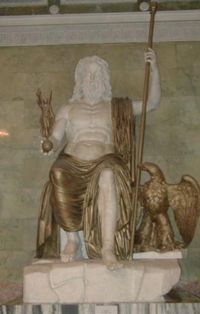Statue of Zeus at Olympia: Difference between revisions
imported>Richard Nevell (Background) |
imported>Richard Nevell No edit summary |
||
| Line 7: | Line 7: | ||
Olympia in the south of Greece was a sacred site to the ancient Greeks. It was a santuary of [[Zeus]], king of the the [[Ancient Greek pantheon of gods|Greek pantheon of gods]] and the site of the [[Ancient Olympic Games|Olympic Games]], which honoured Zeus. According to tradition the games began in 776 B.C., yet [[archaeology|archaeologists]] have deomstrated there was ritual activity at Olympia pre-dating this, and over the centuries various buildings providing for pilgrims and religious activities were built. One such structure was the Temple of Zeus constructed between 466 B.C. and 456 B.C. (it would have looked something like the [[Parthenon]] which still stands in [[Athens]]).<ref>Price, "The Statue of Zeus at Olympia", pp 59–61.</ref> | Olympia in the south of Greece was a sacred site to the ancient Greeks. It was a santuary of [[Zeus]], king of the the [[Ancient Greek pantheon of gods|Greek pantheon of gods]] and the site of the [[Ancient Olympic Games|Olympic Games]], which honoured Zeus. According to tradition the games began in 776 B.C., yet [[archaeology|archaeologists]] have deomstrated there was ritual activity at Olympia pre-dating this, and over the centuries various buildings providing for pilgrims and religious activities were built. One such structure was the Temple of Zeus constructed between 466 B.C. and 456 B.C. (it would have looked something like the [[Parthenon]] which still stands in [[Athens]]).<ref>Price, "The Statue of Zeus at Olympia", pp 59–61.</ref> | ||
The temple was not intended to accommodate worshipers, but instead provide protection from weathering for religious paraphenalia. It is uncertain what this was to begin with, but it was replaced by a statue of Zeus. The sculptor Pheidias was commissioned to create the statue, and already had a reputation for work of outstanding quality. The Parthenon freize may have counted among his works. The statue of Zeus was created by fixing [[ivory]] and gold to a wooden frame.<ref>Price, "The Statue of Zeus at Olympia", pp 62–63.</ref> | |||
==References== | ==References== | ||
{{reflist}} | {{reflist}} | ||
Revision as of 18:14, 1 August 2013
The Statue of Zeus at Olympia was built in the 5th century B.C. by Pheidias and was considered one of the Seven Wonders of the World.[1]
Olympia in the south of Greece was a sacred site to the ancient Greeks. It was a santuary of Zeus, king of the the Greek pantheon of gods and the site of the Olympic Games, which honoured Zeus. According to tradition the games began in 776 B.C., yet archaeologists have deomstrated there was ritual activity at Olympia pre-dating this, and over the centuries various buildings providing for pilgrims and religious activities were built. One such structure was the Temple of Zeus constructed between 466 B.C. and 456 B.C. (it would have looked something like the Parthenon which still stands in Athens).[2]
The temple was not intended to accommodate worshipers, but instead provide protection from weathering for religious paraphenalia. It is uncertain what this was to begin with, but it was replaced by a statue of Zeus. The sculptor Pheidias was commissioned to create the statue, and already had a reputation for work of outstanding quality. The Parthenon freize may have counted among his works. The statue of Zeus was created by fixing ivory and gold to a wooden frame.[3]
